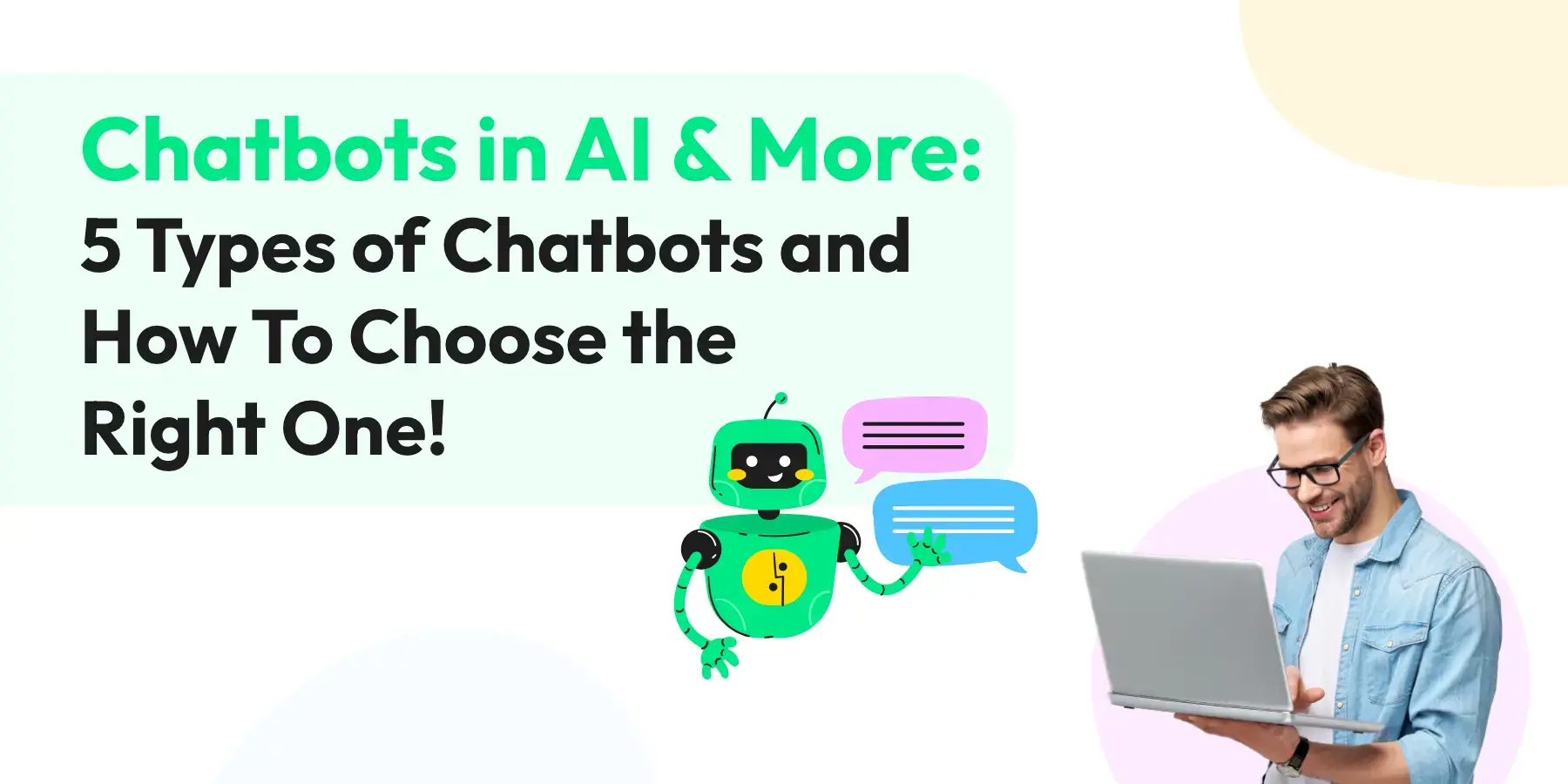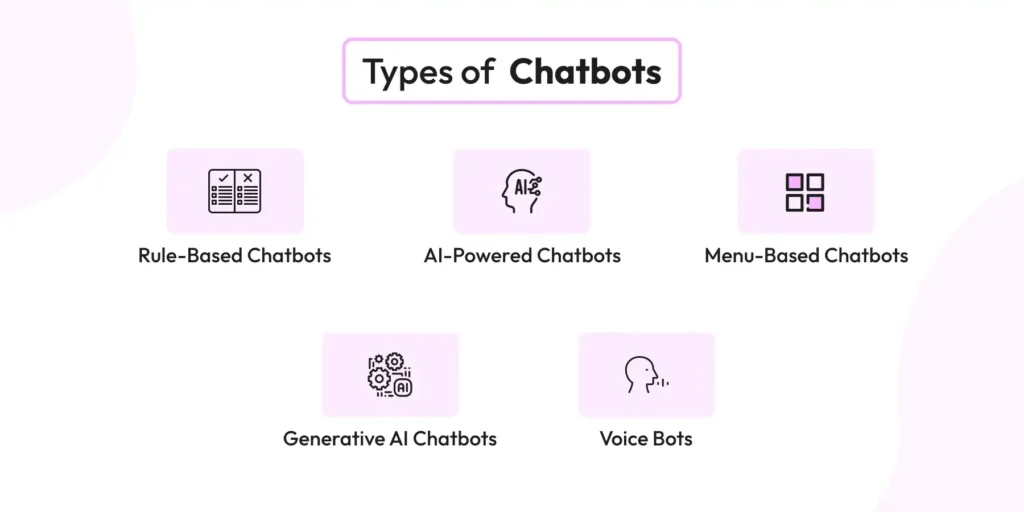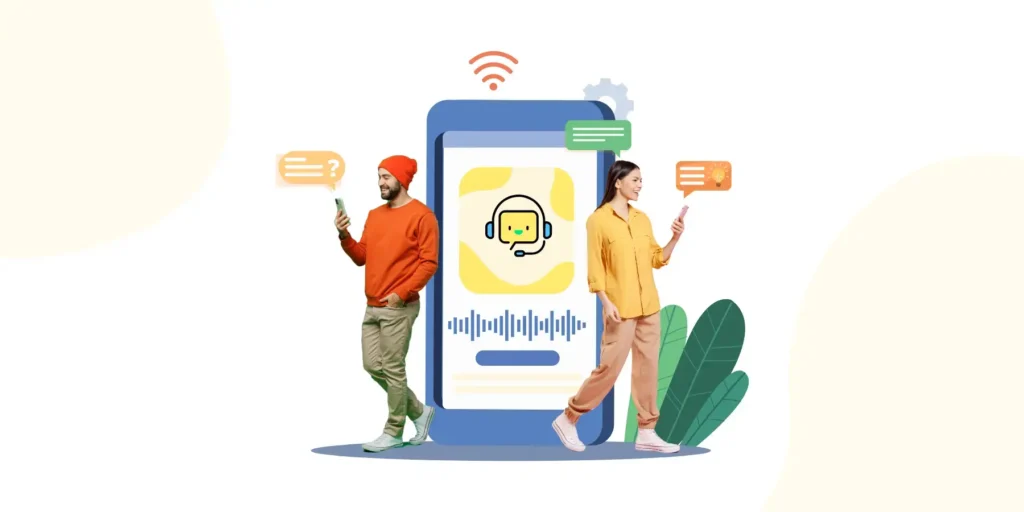-
-
FeaturesคุณสมบัติPenyelesaianRecursosFiturCaracterísticas精选功能功能特點المزايا
-
Solutionsโซลูชั่นPenyelesaianSoluçõesSolusiSoluciones解决方案解決方案الحلول
-
IntegrationsการผสานรวมIntegrasiIntegraçõesIntegrationsIntegraciones集成整合服務دمج مع تطبيقات أخرى
-
Affiliate/Partnersพันธมิตร/พันธมิตรทรัพยากรAfiliasi/Rakan KongsiAfiliados/ParceirosAfiliasi/MitraAfiliados/Partners联盟/合作伙伴聯盟/合作夥伴شريك
-
ResourcesจองการสาธิตSumberRecursosSumber dayaRecursosالموارد資源中心

Chatbots in AI & More: 5 Types of Chatbots and Choosing the Right One!
In an age overpowered by instant communication, chatbots in AI have become the unsung heroes of seamless interaction. From answering customer queries to boosting internal efficiency, these conversational agents are game-changers.
I’m sure that each of us has interacted with a chatbot at some point in our lives. Think of all those websites that come with a virtual assistant, the Google Assistant or Apple’s Siri, for that matter. They are indeed a blessing in disguise.
As per a report by Gartner, chatbots will become the primary customer service channel by 2027. Crazy, right? If you haven’t already, it may be time to invest in a chatbot for your business.
But how does one do that? First, you need to understand the different types of chatbots available today. And we’re going to help you with precisely that.
Stay tuned to explore the different options available to you and how you can choose the ideal one.
What is a Chatbot?

A chatbot is a tool that uses artificial intelligence and human language to understand and respond to customer questions, just like a human would in a conversation.
Chatbots provide quick and efficient assistance by analysing customer queries and generating appropriate responses. They are vital in enhancing customer support processes and offering immediate help and information.
While not all chatbots are equipped with AI, most modern chatbots in 2025 certainly are.
What Value Do Chatbots in AI Provide?
Chatbots in AI are changing the game by providing instant and personalised support around the clock.
Let’s discuss the value that chatbots bring.

Enhanced Customer Engagement
Chatbots are transforming customer service by offering real-time assistance and resolving queries promptly. With their ability to understand natural language and context, chatbots in AI provide a seamless and interactive experience for users, leading to higher engagement and satisfaction levels.
24/7 Availability
One of the critical advantages of chatbots is their round-the-clock availability. Unlike human agents, chatbots in AI can handle multiple queries simultaneously and provide instant responses at any time of the day. It ensures that customers receive timely assistance and support, enhancing overall user experience.
Cost-Effective Solution
Implementing chatbots in AI can significantly reduce operational costs for businesses. By automating routine tasks and handling a large volume of customer inquiries, chatbots help streamline processes and improve efficiency.
This cost-effective solution allows organisations to allocate resources strategically and focus on core business activities.
Personalised Interactions
Most chatbots leverage AI algorithms to analyse user data and preferences, enabling them to deliver personalised recommendations and responses.
By understanding user behaviour and history, chatbots can tailor interactions to meet individual needs, creating a more personalised and engaging experience for customers.
Seamless Integration
Chatbots in AI can be seamlessly integrated across various platforms and channels, including websites, messaging apps, and social media platforms. This omnichannel presence ensures consistent and cohesive communication with customers, regardless of the platform they choose to engage with the brand.
Also Read: The Benefits of Using an AI Chatbot for Your Business on WhatsApp
Chatbots in AI & More: Different Types of Chatbots

Let’s get to the thick of things. Read on to learn about the various chatbots in AI available today.
1. Rule-Based Chatbots
Rule-based chatbots work based on a predetermined set of rules and responses that guide their interactions. These chatbots are designed to handle straightforward questions and offer fundamental information to users.
Think of them like virtual assistants following a script. They operate in a step-by-step manner, which means they follow a linear path in conversations, making them suitable for addressing uncomplicated inquiries.
These chatbots are especially useful for businesses in initiating lead generation. They achieve this by supplying pre-programmed responses to potential customers and guiding them through basic queries and information.
Despite their effectiveness in handling simple tasks, rule-based chatbots have limitations when faced with more intricate questions or scenarios that deviate from their predefined rules.
2. Chatbots in AI (AI-Powered Chatbots)
AI-powered chatbots harness machine learning algorithms’ power to scrutinise and comprehend user inputs. Unlike rule-based chatbots, these advanced chatbots in AI excel in handling more intricate conversations. They go beyond mere rule-following and can learn from user interactions, adapting and evolving over time.

The distinguishing feature of chatbots in AI lies in their capability to provide personalised responses based on user behaviour. Through the analysis of past interactions, these chatbots in AI can discern patterns and preferences, tailoring their replies to match the individual needs of users.
Picture this: You’re chatting with a super-smart AI buddy while shopping online for cool running shoes. You type in, “Can you help me find the perfect pair?” Bam! The AI buddy, armed with its brainy algorithms, checks out all your previous buys, what you’ve been eyeing, and what makes you smile.
Instead of hitting you with a plain answer, this clever buddy uses what it’s learned to suggest the best running shoes just for you. This personalised approach enhances the overall user experience, making the interaction with the chatbot feel more individualised and intuitive.
One of the key strengths of chatbots in AI is their continuous improvement in language processing capabilities. As they encounter diverse inputs and feedback, these chatbots refine their understanding of language nuances, enabling them to engage in more natural and human-like conversations.
This adaptability and learning capacity enhance the chatbot’s performance, making it increasingly adept at delivering a seamless and sophisticated interaction experience for users.
3. Menu-Based Chatbots
Imagine you’re in an online store, and these chatbots are your friendly guides. They work a bit like the buttons on an ATM, laying out options for you. Instead of scratching your head over what to do next, these chatbots simplify everything with preset menus.
So, let’s say you’re eyeing a fabulous pair of sneakers. You ask the chatbot about them, and it doesn’t just stop there. It smoothly takes you through the process – from answering your questions about the product to helping you finalise your purchase at the checkout.
However, these chatbots might face challenges when dealing with more detailed requests because they can only pick from set answers.
For starters, they might take more time to figure out what the customer wants, especially if the user has to click through a bunch of menu options before getting to the right one. Plus, if what the user wants isn’t in the menu, the chatbot can’t help because it doesn’t let users type in their messages.
4. Generative AI Chatbots
Another chatbot in AI type that you can consider is generative AI chatbots. These sophisticated bots don’t just grasp common language; they seamlessly adapt to your conversational style and respond with a touch of empathy.
While traditional conversational chatbots in AI can mimic human-like responses, the generative AI counterparts take it up a notch, crafting entirely new content. Think polished text, vivid images, and nuanced sound, all inspired by the extensive language models that fuel their capabilities.
What sets these chatbots in AI apart is their independence—they don’t rely on human interaction. Generative chatbots in AI effortlessly recognise, summarise, translate, predict, and generate content in response to your queries.
5. Voice Bots
Companies are starting to use voice-based chatbots or voice bots to make talking to computers more common. These voice bots have become more prevalent in recent years, with virtual assistants like Siri from Apple and Alexa from Amazon leading the way. Why are they becoming so popular?

It’s all about making things more convenient. Speaking is much simpler for customers than typing. When you use a voice-activated chatbot, it makes the whole experience smooth and easy for the customer. As per a report by the Industry Arc, the voice bots market size is estimated to reach $98.2 billion by 2027.
Despite their convenience, voice-activated chatbots in AI have some drawbacks. They may need help understanding accents or specific pronunciations, leading to misinterpretations. Additionally, privacy concerns arise as these bots often listen for commands, raising questions about data security and the potential misuse of recorded conversations.
Choosing the Right Chatbot in AI For Your Business
We get it. With many chatbot options available in the market (as mentioned above), choosing the right one for your business can be daunting.
To make things easier, we will walk you through the key factors to consider in this section. It will help you select a chatbot that aligns with your business needs and goals.
A. Clarify Your Goals
Before delving into chatbots in AI, it’s crucial to state your objectives clearly. Do you want to enhance customer support, boost lead generation, or automate repetitive tasks? Understanding your aims will help you pinpoint the features and abilities needed in a chatbot.
B. Understand Your Audience

Identifying your intended audience is vital when picking a chatbot. You can consider factors like age, preferences, and how your audience communicates to ensure the chatbot connects with your customers and delivers a smooth user experience.
C. Assess Chatbot’s AI Skills
AI is the foundation of chatbot technology, enabling them to comprehend natural language, learn from interactions, and provide intelligent responses.
When choosing a chatbot, evaluate its AI capabilities, including natural language processing (NLP), machine learning, and sentiment analysis, to ensure it can engage in personalised and contextually relevant conversations.
D. Incorporation and Adaptation
A chatbot seamlessly fitting into your existing systems and platforms can boost operational efficiency and data management. So, seek chatbot solutions that easily integrate with popular CRM systems, e-commerce platforms, and messaging apps. Additionally, consider the level of customisation available to tailor the chatbot’s functions to match your specific business needs.
E. Growth and Assistance
As your business expands, your chatbot should be able to grow along with it, handling increased user interactions and changing requirements.
Finalise a chatbot provider that provides scalability options and dependable customer support to address any technical problems or customisation requests promptly.
Chatbots in AI: How Wati Can Help
Most of your customers today aren’t on email or your website. Instead, you’ll find them on a platform that has seeped deeply into our lives: WhatsApp.
Wati understands that. So, it focuses on the communication platform, ensuring businesses can talk to customers where they spend a large chunk of their time.
Wati KnowBot is created to easily integrate with the knowledge you upload, allowing it to swiftly answer questions about the information you provide. It helps provide excellent customer support and makes your support operations more efficient.

Wati also makes it easy for businesses to use intelligent WhatsApp chatbots in AI. That’s not all. Wati even saves time by handling routine messages, helping businesses like yours to capture more leads and connect with more customers.
As a result, you get to create friendly and personal interactions online, making it easier to succeed in the digital world.
Conclusion
When it comes to chatbots in AI, it’s crucial to use the technology and pick the right type of chatbot that aligns with your business goals.
By making an intelligent choice, you can use chatbots to improve how customers interact with your business, make operations more efficient, and stay ahead in today’s competitive business world.
You can pick the ideal one from the options mentioned above and see your business thrive!
Frequently Asked Questions About Chatbots in AI
Why are chatbots in AI used?
Chatbots in AI are used to automate and enhance customer interactions, provide instant support, and streamline communication processes.
How do chatbots in AI work?
Chatbots use natural language processing and machine learning algorithms to understand and respond to user queries, improving over time through data-driven insights.
What are hybrid chatbots?
Hybrid chatbots combine rule-based and machine-learning approaches. It allows them to handle predefined tasks efficiently while learning from user interactions to improve over time.
What makes a conversational AI bot different?
Conversational AI bots focus on natural language understanding, enabling more human-like interactions and understanding the context for better communication than traditional rule-based bots.
Latest Comments